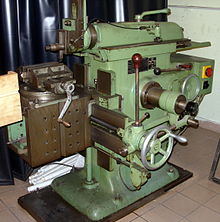Slotting machine
A shaping machine , often shaper called, is a machine tool for cutting metalworking with horizontally-linear movement of the chisel, the bumping . The English name is Shaping Machine or just Shaper , from which another name in German-speaking countries was derived: Shaping .
In contrast to the planing machine , the workpiece is clamped and is automatically fed in with each stroke of the cutting chisel by the previously set stroke, transverse to the direction of stroke of the chisel, step by step and during the idle stroke (backward movement of the tool). The tool moves over it.
application
Slotting machines were widespread until the 1970s because they are ideally suited for the non-repetitive tasks of tool and mold making and small series. The creation of planes, polygons and above all guides was a domain of the shaping machine. Internal gears, spline shafts and gears are also to be mentioned . The shaping of castings for the first time and the severing of the casting skin, which the tool quickly wears out (sand inclusions, hard spots in the cast), were also applications for the shaping machine. The surface finish that a high-speed planer creates leaves milled surfaces far behind, e.g. B. gear flanks no longer need to be ground for finishing .
Current meaning
Slotting machines have largely disappeared in industrial use today. Reasons for this are on one hand the inefficient operation (limited and during the section-changing cutting speed, also each working stroke, a return stroke without performance of work) and on the other hand, the use of CNC -controlled machine tools and cemented carbide tools . In most cases it has been replaced by milling machines . For small businesses and hobby users, however, the slotting machine remains an interesting machine with the following advantages:
- cheap and geometrically simple tools;
- high surface quality achievable;
- low purchase price;
- high flexibility;
- very quiet in operation;
- low power consumption;
- Ability to cut internal gears and splines.
construction
The machine is usually divided into the main parts:
- Slide with angle adjustable tool holder
- Machine body
- engine and gears
- Cross table
- Machine base (machine frame)
kinematics
The tool slide is driven by a crank arm or an oil hydraulic system, which converts the circular movement of the drive motor into a linear movement.
Due to the crank arm, the speed of the slide is not constant. Cutting is performed as the slide moves forward, while the tool moves backward from the workpiece surface so as not to scratch it. The advance is slower than the reverse.
In the return of each cut, the table on which the workpiece lies is advanced by a small amount by a ratchet that is driven by the crank arm. The workpiece moves slowly under the cutting tool and is successively machined.
Tools
The tools are usually made of HSS or SS, as the machining conditions for hard metals or ceramic cutting materials are not suitable due to the non-continuous cut and too low and changing cutting speeds. An advantage on the other hand is the simple tool geometry. The chisels for a speed planer are single-edged tools that are similar to turning chisels . Such tools are geometrically comparatively primitive.
Cutting speed
The cut is made intermittently and at a changing speed. Depending on the length of cut on the workpiece, between 50 and 200 strokes per minute are common.
Manufacturer
Well-known German manufacturers were Klopp (Solingen), Wotan , Gack and Erdmann .
In American countries, the manufacturers South Bend , Atlas and Ammco are widespread for small machines , while the manufacturers Cincinnati and Gould & Eberhardt for large machines .
literature
- Günter Spur: Manual Machining and Ablation. Carl Hanser Verlag, Munich 2014, ISBN 978-3-446-42826-3 .
- Georg Schlesinger, Max Kurrein: Investigation of a horizontal shaping machine with an electric single drive and intermediate belt links. Springer Verlag Berlin Heidelberg GmbH, Berlin Heidelberg 1921.
- Friedrich Wilhelm Shell: The machine tools and their construction elements. Third edition, Springer Verlag Berlin Heidelberg GmbH, Berlin Heidelberg 1913.



